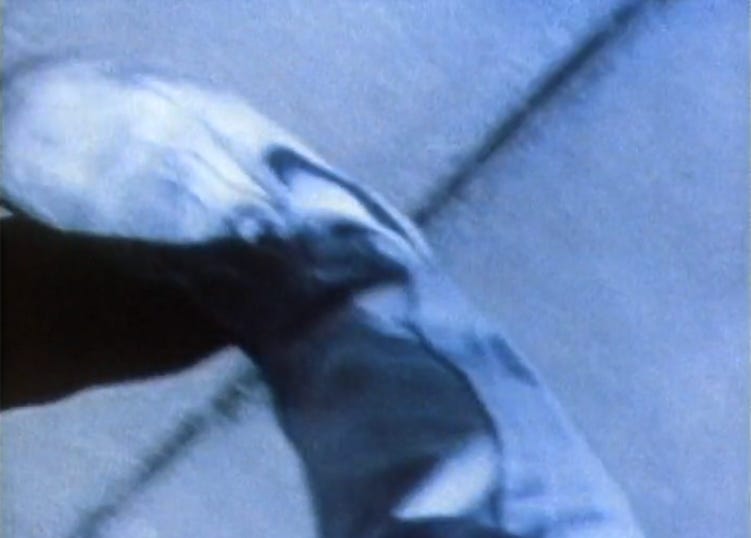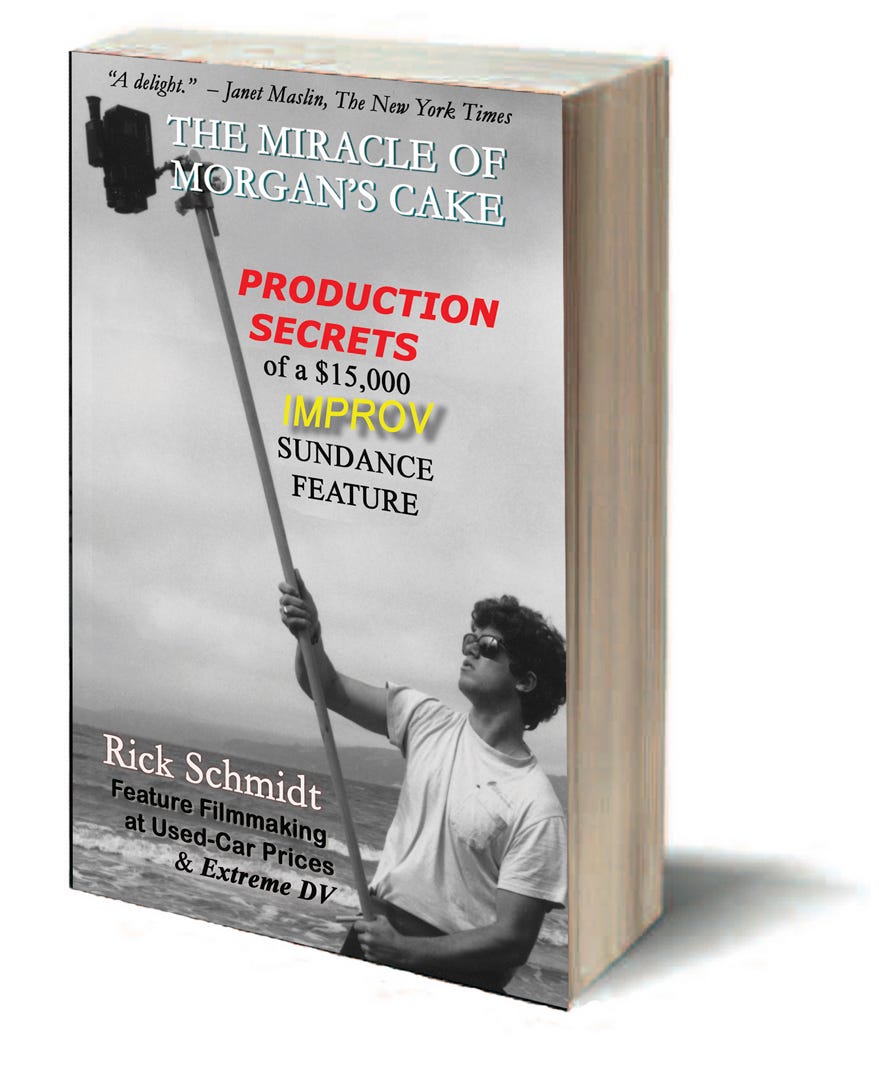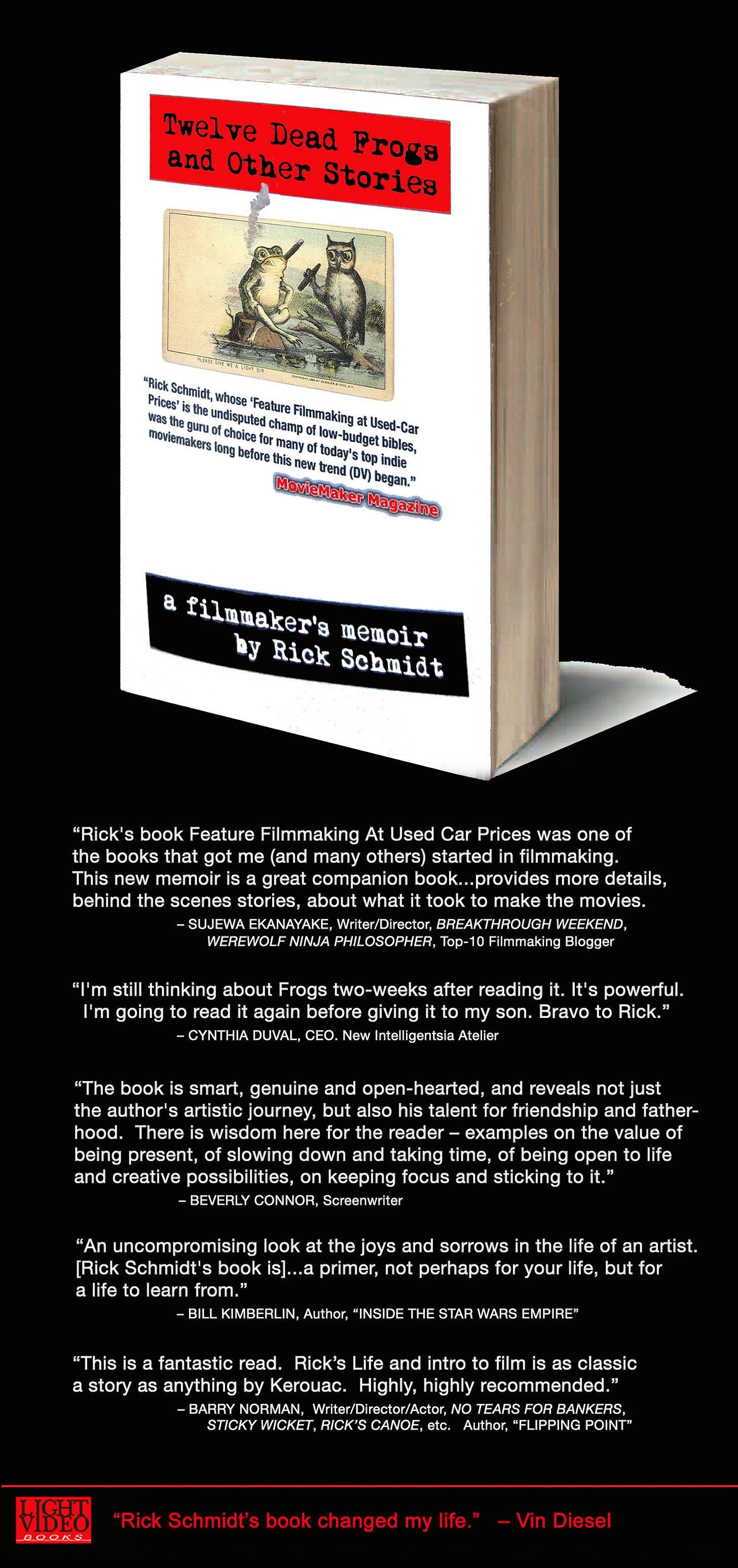Still runnIng with MORGAN'S CAKE! Check out the many IMPROV decisions that were made while shooting on-the-fly with non-actors. (Plus the 'filmmaking miracles' that came my way!).
Watch MORGAN'S CAKE (87 MIN., ©1988): <https://vimeo.com/168153085>.
Excerpted from book, THE MIRACLE OF MORGAN'S CAKE––Production Secrets of a $15,000 IMPROV Sundance Feature").
Time for a quick reality check. Can you depend on such a flow of gifts while shooting? Can you take your planning for granted? NO. You must be as fully prepared as possible going into the shoot, even if that means you only have a rough idea of locations and the people needed to act in the scenes you have listed. Then, when things go wrong, or something crosses your path that you deem valuable, you can quickly adjust, stitch it into the ongoing patchwork of ideas. Just figure on keeping some flexibility built into the daily schedule, so that unknown entities (new characters, locations, and situations) can be allowed to enter your moviemaking reality.
NOTE: Remember that every problem thrown in your way during the shoot is there to benefit the production. Why? Because you have to think out-of-the-box, beyond your normal scope. If you grow as a person/problem-solver then so will your movies.
Color Video Surfing Shots
By now, after four days of shooting, we had hit the weekend, and while I took a one-day breather, Morgan said he would try to get some surfing shots with my Sony Hi-8 video camera. I had somehow worn down the officials at Sony Corporation enough with repeated phone calls to the US Division in San Francisco that they’d granted me the loan of one of their underwater video camera housings for a few days. At last I was told to stop by the Bay Area corporate Sony headquarters, where they handed over a lightweight plastic, waterproof, wrap-around contraption that perfectly accommodated the Sony Hi-8 video camera I had bought at Wards.
NOTE: The moviemaker needs to be super- persistent to get the freebees he/she needs when their budget comes out of their own wallet or credit cards. Make sure that you start the request process early enough (at least a month prior to the shoot) to get a satisfactory responses. Keep track of your calls on a bulletin board or personal calendar. Just remember that anything you need for your feature can be procured with the right attitude. Don’t let the lack of money slow you down. If you are making an honest work, you will be graced with the necessary production miracles.
When I passed the camera and housing off to Morgan he was delighted at the possibility of blending his interest in moviemaking with surfing. But when he stopped by my house later, on Saturday afternoon, after a day of surfing in Santa Cruz with the video camera, he had a look of defeat on his face. He explained that his buddy, Sean, had helped videotape a few of his better passes as he rode the waves, and maybe that footage was OK, but most of the tape was used up when they forgot to turn the camera off while towing it back to shore. Not a very confidence-building report, I’m afraid.
After hearing that, I didn’t even bother to play the tape. Later in the editing (half a year later), only when my curiosity matched my need for some surfing footage to transfer to film, did I discover that the long underwater shot was filled with truly striking images; swirls of light and colors, bubbles passing by, a lovely and unusual abstraction of moving water before the Hi-8 had finally bobbed to the surface to reveal a glimpse of Northern California shoreline. When that footage was later paired with an equal-length jazz piano solo by Gary Thorp, it became one of the highlights of Morgan’s Cake. And the surfing shot with Morgan spraying water toward the video camera as he sailed by also became an important element, letting us see him actually using the surfboard we’d watched him wax in the very first scene.
No-Budget Dolly Shot
I had gotten the idea that I wanted to have Morgan walk with Rachel down the main street of Point Richmond, along the exact stretch that the viewer had seen out the window during Morgan’s introductory monologue. I had no idea what subject they would discuss – in my list that I had scribbled out each morning or evening, I’d just written, “Sidewalk dolly (Morgan and Rachel) Sunday?” Sunday seemed like an appropriately quiet time of the week to shoot something out in public like that. Hopefully we wouldn’t have to deal with too many passing cars, or other unwanted sounds which might interfere with on-location recording of dialogue.
If I’d had portable radio mikes back then – indispensable for any DV moviemaker’s sound package these days – and a tiny broadcast-quality DV camera, no one would have paid much attention to our activity. But with a boom pole and mike, accompanied by a large film camera, we looked Hollywood- enough for some people to stop and stare. Even so, I decided to try shooting from a borrowed wheelchair, hoping its rubber- edged wheels would provide a smooth-enough ride while I floated the camera in my hands. Happily for the production,
Rachel and Morgan showed up right on schedule, looking fresh and youthful with their white T-shirts and sun-tanned faces. I couldn’t help noticing that they seemed to been joying the process of filming, thriving on all the attention of being in the spotlight. These are the kind of people you ultimately want on-screen, those who enjoy it – without over-acting!
And although Morgan continued to apologize about the supposed “surfing footage” screw-up (we didn't know the footage was great yet), he seemed much more self-assured when I handed him the video camera-as-prop – it seemed like a natural extension of his arm as he jockeyed it around. I got a good feeling watching him, as if his newly-developed cameraman skills could add a sense of legitimacy to the “Morgan” character and the video shots I hoped to include in the final editing mix. I told him to keep playing with the camera on their walk, shooting Rachel and the scenery, as they moved along down the block back toward Jumbo's restaurant.
OK, so it was time to shoot the dolly shot. Kathleen and Nick were there to help again (my crew of no-budget saints!), and around 10:30 AM we attempted out first stroll down the sidewalk. I sat in the wheelchair, cradling the Eclair which was now wrapped in my coat and a few blankets in addition to the sound-proof barney. The challenge was to stay just in front of Morgan and Rachel and keep them framed properly as Kathleen rolled me backwards over the cracks and crevices of the WPA-era cement. It took a few tries to get my arm muscles primed sufficiently for a steady shot, but finally by Take #3 I was ready for the real thing. Nick reported that sound was “good” and said that no cars were coming.
NOTE: Use a garage-sale wheelchair, suction- cup car mounts, hand-made crane rigs when appropriate, whatever you can affordably secure to add some motion to your motion picture.
The expression, having your cake and eating it too had been echoing in my mind lately (the “cake” connection), and between takes I asked Morgan and Rachel if they had heard of it (Yes, they replied in unison). I told them to try and talk about that. I listened a bit to what they came up with on their own and finally “packaged” their thoughts into a scene. All I really needed for their walk, I figured, was some lightweight banter while I examined the two of them, their youth, future hopes and dreams written across their faces. Appropriately enough, Rachel and Morgan had brought some strawberry-topped pastries with them for snacks that morning, so Rachel could top the scene off by actually presenting “the cake.” I hadn't been aware we needed a cake for the shot, but there it was! Great, again!
At least within the confines of the conversation the word “cake” would be prominent, lead in some small way to the ending I envisioned. The scene was jelling, just like a good jazz riff. And the collaboration was so easy. People just chatting, having fun, coming up with material that fit the overall construct. That’s moviemaking at its best.
Camera rolling. Action!
Morgan, as instructed, waited until he and Rachel had walked for about ten seconds before speaking, then brought up the cake expression. Why can’t you eat your cake? Why can’t you eat it? he asked. Rachel responded, You can, and pressed the strawberry confection to Morgan’s lips. Kind of cute, I know, but the movie could handle it...
(Rachel had some cake for Morgan!)
As in the case of the surfing shots, it would be months before I would actually view Morgan’s shot with the Hi-8 camera. When I did finally see it, I couldn’t help noticing that Morgan had again forgotten to turn the camera off. So, for his and Rachel’s walk across the street (after the dolly shot wrapped), the Hi-8 recorded the ground – just the pavement at their feet (in focus and usable thanks to the auto-focus and auto-exposure) – with his feet, Rachel’s and the camera’s shadow moving in and out of the frame.
And again, I later found that a “mistaken shot” (the strange, backwards, jerky, swinging frame, with a bluish tint to the cement and shadows) worked beautifully with Gary Thorp’s great piano jazz soundtrack. When these “accidents” of the shoot were cut together – the loose color video shots alternating with the B&W footage – freshness was brought to the story, giving it some of the spontaneity and unpredictability of youth, the innocent abandon we’ve all felt at some point in our lives.
NOTE: Don’t wrap your movie, DV or otherwise, into too tight a conceptual (scriptwriter’s) cocoon. Let the muse in, to dance and deliver some special “mistakes” that can liven up your work. If you're lucky, as I have been, your material can take on its own life, way beyond your own present skill level.
So I had no idea about the beautiful walking video shot that was already “in the can.” I was just following my intuition, connecting the dots as I proceeded to shoot my movie. I had a hunch that the dolly scene should end with Morgan and Rachel crossing the street and entering the street-level doors of our office building. Then they could possibly climb the stairs to Morgan and his Dad’s small office/bedroom above. I figured I could show that entrance hallway, which would explain part of Morgan’s life, that demarcation point from where he departed each day for work, went from his inner world to the exterior world.
NOTE: Visually crisscross location spaces with your actors, catching them at different angles. That helps make the locations real on some intangible level. Answer some unspoken spatial questions that the already-shot footage seems to be asking, such as I did; “What does the downstairs hallway look like, where Morgan disappeared to after hearing that message from his mother? Shoot your scenes from more than one angle, as you build up 1:1 cuts that form a sequence. Crisscrossing the documentation of a location helps give a sense of reality to the core of the story you're telling.
On-the-Spot Props and Set Design
By now, the shoot was approaching noon of Day-Six. As I set up the tripod inside the lobby alcove, ready to shoot Morgan and Rachel coming in, I spotted several letters on the floor, legal-sized envelopes that had been shoved through the slot by the postman. Seeing the mail like that, nice white rectangles against a dark carpet, gave me an idea. What if there was a letter waiting for Morgan...from...from...the WhiteHouse!
A few weeks earlier I had purchased a great fold-out card that featured a White House image. Through the magic of paper cutting, the facade of the White House raised up in 3-D when the card was unfolded. It was white paper of course, clean white-on-white, no caption, and rather elegant – what the U.S. government would never in a million years send their future draftees. I thought, Wouldn’t it be funny – serious as well – to see Morgan spot a letter addressed to him, open it, and read the news of his impending draft on that classy card?
After I told the cast and crew to take a quick fifteen minute break (remain there in the hallway...), I rushed up to my house just six blocks away, jammed the card into my electric typewriter and quickly pounded out words, “from the President of the United States.” Without any hesitation (I had no time!), I typed in that Morgan had been drafted, “to defend our shores against the Red Menace.” Back on the set I added my envelope to those on the floor. Then, with a static shot that was angled down toward the mail slot, I shot Morgan and Rachel coming in the door. At first, all you could see were their legs moving through the doorway until Morgan crouched down to read the White House letter. With a voice command I told Rachel, Move in tighter to Morgan, and as she bent down very naturally she asked, What is that? Because Morgan had kept staring at that letter, remaining silent, she had felt the need to blurt something out.. Finally, he opened it, stared some more in feigned amazement before reading my “Red Menace” text.
NOTE: With an improvisational attitude during the shoot, you can still make great additions to your story mid-stream, building shots from special props you gather during pre-production.
Because I was shooting wide, and part of Morgan's arm partially blocked the card, I called Cut and went in for a close- up. With a little effort I was able to fill the screen with the White House image, keeping both the text and fold-out in focus while Morgan held it steady in his hands. In editing, that shot gave me the option of cutting to the card as he read the text out loud to Rachel. So the shooting process had impelled me to use a prop I had inadvertently collected before the shoot began, something I had stored away and forgotten about until the very moment of need arrived.
————
(FYI: My memoir is included in a FREE PROMOTION at Kindle Oct. 4-9, so check it out!): <https://www.amazon.com/dp/B0777FHXX2>
———








“Remember that every problem thrown in your way during the shoot is there to benefit the production. Why? Because you have to think out-of-the-box, beyond your normal scope. If you grow as a person/problem-solver then so will your movies.
“If you are making an honest work, you will be graced with the necessary production miracles.
“Let the muse in, to dance and deliver some special “mistakes” that can liven up your work. If you're lucky, as I have been, your material can take on its own life, way beyond your own present skill level.”
As I’ve come to believe that our Lifetime is much like a movie we’ve CHOSEN to be in, it’s so clear to me that this “moviemaking” wisdom has “real life” application in this Movie we’re all making.